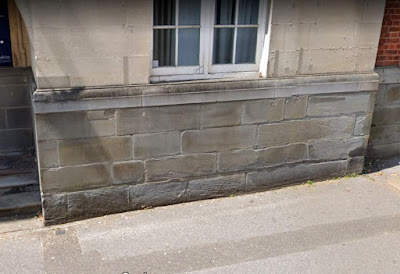 |
| Samples from Aldershot Town Hall |
In my experience of building stones, I usually associate the mineral glauconite with the Cretaceous Upper Greensand and Lower Greensand of the Weald, although the latter is very often not green or sandy, and these are known for the quarrying of Reigate Stone and Kentish Ragstone respectively.
 |
| Google Street View of Aldershot Town Hall |
When examining the sample of sandstone from Aldershot Town Hall under the hand lens, I can see specks of a very dark green/black mineral and areas of general green staining that I think may be glauconite, but petrographic analysis is needed to confirm this.
 |
| A collection of small rock samples |
In my current rock collection, I have a few pieces of Kentish Ragstone that I found when I visited Rochester a few years ago, which include fragments of the city wall, the north-west bastion to the castle and stone that was being used for the repair of a rubble wall not far from the cathedral.
 |
| Comparison with samples of Kentish Rag |
A test with hydrochloric acid this time produced positive results and an examination with a hand lens also reveals black/dark green/green grains, which are obviously glauconite.
 |
| A hydrochloric acid test |
Back in 1997, I obtained several samples of stone for the Triton Stone Library that were marketed by Nickolls Quarries as Folkestone Rag and Newington Rag, which I have always assumed were extracted from the Hythe Formation in this area.
 |
| The Triton Stone Library |
I recall that some of them were distinctly dark grey/green in colour and, although I can no longer find any information on this stone nor have I had samples of it myself, I thought that it was worth obtaining some samples of Kentish Ragstone that is now cut and tooled with modern machinery by Gallagher's in Ashford.

No comments:
Post a Comment